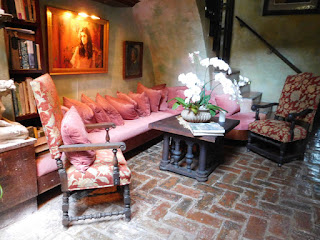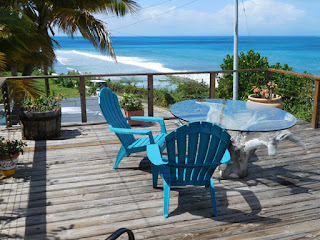We left Rhode Island on Southwest Air, an early morning flight to Chicago then on to Las Vegas. Both flights were packed, but arrived on time and with luggage.
The Las Vegas airport is not an experience to recommend. A walk plus tram ride to baggage claim, a huge place with hundreds of people trying to get their luggage. Then line up for a bus ride to the car rental building, line up again to see the person at the counter, who tries to get you to upgrade (no thanks) and tries to scare you into buying more insurance (again, no thanks).
 |
| View from the Bellagio Casino |
Finally, in the car and riding down the Strip. It is Disney for adults- Egyptian pyramids, the Statue of Liberty and the Brooklyn Bridge, the Eiffel Tower and Arc de Triomphe, Rome, Venice complete with gondolas- it's crazy. We're staying at the Flamingo, right in the middle of the action. After parking in their garage, we check in. They want $30. for early check-in but will waive it if I get a rewards card, so I do. A good room on the 10th floor, facing the Strip, but don't expect little niceties like a coffeemaker. If you want to eat or drink, go downstairs to one of the many restaurants and bars.

We go out for a walk and food. Las Vegas has gotten huge since we were there last, nearly 20 years ago. Much more traffic, more people, crowds on the street like New York. We get a bite to eat and a beer at a sidewalk place and watch 2 gorgeous blonde girls who are dressed like cops, except with bikinis and platform boots along with the handcuffs, nightsticks and leather jackets. Everyone- well, every guy- wants to have their picture taken with them, and they're pulling in money like crazy. The waiter says they're there every day, so they must be doing pretty well.
In Las Vegas, you always feel like you're being hustled. FYI- those "free" tickets to shows may well have one-drink minimums, and the half price "Tix4tonight" may be for general admission, not reserved seats, which could mean more standing in line.
Las Vegas is surrounded by mountains and has some fantastic scenery. The next day we head out to
Red Rock Canyon National Conservation Area, which I highly recommend. You can just ride the 13 mile loop road, or stop and do some hikes.
 |
| Red Rock Canyon |
We also visit
Valley of Fire State Park, which I also recommend, about an hour's drive west of the city. On our way back to Las Vegas we drive through the
Lake Mead National Recreation Area. Breathtaking, constantly changing desert scenery.
 |
| Hiking at Valley of Fire |
We head out to Beatty, NV on the fourth day, where we're staying to visit Death Valley National Park. The weather is great, in the 50's and 60's, sometimes sunny and sometimes overcast. Much better than New England in January. On our way there we stop at
Ash Meadows National Wildlife Refuge. It's pretty amazing to see springs of water in the desert, and even more amazing to read about how the whole place almost became a housing development/ casino/golf course.
 |
| Crystal Spring at Ash Meadows |
We're staying at the Exchange Club Motel in Beatty, right on Main St. Across the street are the Sourdough Saloon, the Happy Burro, and KC's Outpost, all of which we patronize during our stay. The menus are limited but the people are very friendly.
After settling in, we drive 4 miles down the road to
Rhyolite, a ghost town with an interesting story behind it. Lots of picture taking going on here!
 |
| Rhyolite |
 |
| Photographers in Rhyolite |
The next day,
Death Valley. We go to Furnace Creek, stop and hike up Golden Canyon, go to Badwater, and then do the Artists Palette Drive on the way back. Then on to Zabriskie Point and Dante's View, an amazing place to see a bird's eye view of the Valley. We tried to see the Natural Bridge, but the road was rough and we got nervous with our rental car, so we turned around. The park is young and a number of roads are still unpaved.
 |
| Golden Canyon |
 |
| Dante's View |
We were told, one night at the Sourdough Saloon, that Titus Canyon is a must see. The turnoff is a few miles west of Beatty, a one way road through the canyon that ends on Scotty's Castle Rd. Four wheel drive is recommended, and a local bartender told us that getting towed out of there will set you back $2000. Sadly, we decided to skip it, although there are jeep tours if you have the time.
From Death Valley we went to visit friends, then there was a long drive back to Las Vegas to fly home.




























